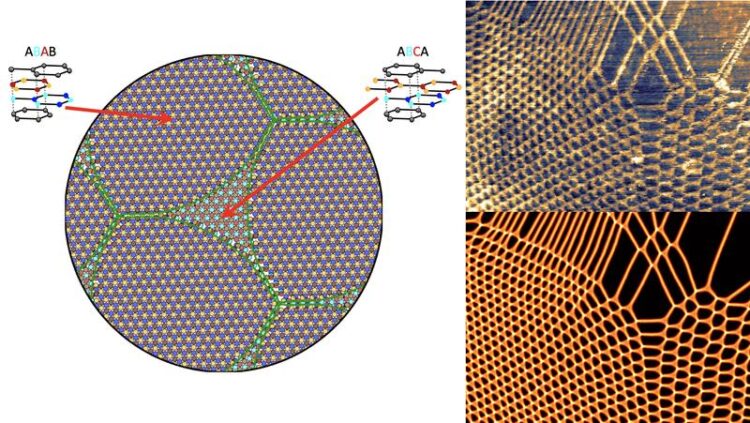‘Moiré metrology’ – a new tool to map the interaction between atomically thin layers

The atoms of the two layers move in search of a stable configuration, forming domains separated by domain walls (left). Moiré metrology reaches great agreement between experiment (top: STM topograph) and modelling.
Dorri Halbertal
When two atomically thin layers of a material are stacked and twisted slightly on top of one another, they can develop radically different properties. They may become superconducting or even develop magnetic or electronic properties due to the interaction of their two layers. The challenge for scientists is to find out precisely what happens in these ultra-thin double layers – and how these changes can be induced and tuned. Now a research team from the United States and Germany has developed a groundbreaking method to map the interaction between such layers. The work on their new concept, ‘moiré metrology’, has been published in Nature Communications.
When two layers of a material are stacked and twisted, they form a large-scale periodic structure, called a moiré superlattice. The research team from Columbia and Harvard Universities in the United States and the Max Planck Institute for the Structure and Dynamics of Matter in Hamburg and RWTH Aachen explored the atomic landscape and the subtle features of such moiré lattices to gain a better understanding of these systems.
The team developed moiré metrology as a combined experiment-theory framework and applied it to three representative twisted systems: bilayer graphene, double bilayer graphene and H-stacked MoSe₂/WSe₂. Through various imaging techniques and detailed modelling, the researchers deciphered material information imprinted in moiré superlattices and gained information about the interaction between the layers that was not accessible thus far by other means. However, moiré metrology is not limited to a given material system, but can be used across the field of twisted bilayer structures.
At the heart of moiré metrology lies the notion of relaxation. When two atomic layers are placed one on top of the other they do not remain still. In fact, they behave more like deformable membranes, and they stretch and compress in search of stable configurations, based on the interaction between the layers. The authors of this study claim that the information about the interaction is imprinted on top of fine spatial patterns that emerge after the atomic relaxation. They further demonstrate how this information can be extracted for the studied cases, and provide constraints that can guide the future modelling of these systems.
The unprecedented reported sensitivity can be understood from the description of the moiré superlattice in terms of a geometric interference pattern of the lattices of the two layers. So just as minute changes between two paths can be resolved by studying the interference pattern of light traveling across each of them (as was remarkably done in the LIGO experiment, for instance), here sub-atomic shifts in atomic position are projected to a measurable large scale spatial pattern.
Beyond the theoretical implications, the team also developed relaxation simulation tools which can help with the modelling and design of non-uniform strain fields in realistic devices. They show remarkable agreement with the experimental results.
The experimental measurements and theoretical modelling were developed and performed by scientists at Columbia University with theoretical support from the MPSD Hamburg, RWTH Aachen University and Harvard.
Wissenschaftliche Ansprechpartner:
Dorri Halbertal, Lead author: dh2917@columbia.edu
Originalpublikation:
https://www.nature.com/articles/s41467-020-20428-1
Weitere Informationen:
Media Contact
All latest news from the category: Physics and Astronomy
This area deals with the fundamental laws and building blocks of nature and how they interact, the properties and the behavior of matter, and research into space and time and their structures.
innovations-report provides in-depth reports and articles on subjects such as astrophysics, laser technologies, nuclear, quantum, particle and solid-state physics, nanotechnologies, planetary research and findings (Mars, Venus) and developments related to the Hubble Telescope.
Newest articles

First-of-its-kind study uses remote sensing to monitor plastic debris in rivers and lakes
Remote sensing creates a cost-effective solution to monitoring plastic pollution. A first-of-its-kind study from researchers at the University of Minnesota Twin Cities shows how remote sensing can help monitor and…

Laser-based artificial neuron mimics nerve cell functions at lightning speed
With a processing speed a billion times faster than nature, chip-based laser neuron could help advance AI tasks such as pattern recognition and sequence prediction. Researchers have developed a laser-based…

Optimising the processing of plastic waste
Just one look in the yellow bin reveals a colourful jumble of different types of plastic. However, the purer and more uniform plastic waste is, the easier it is to…


